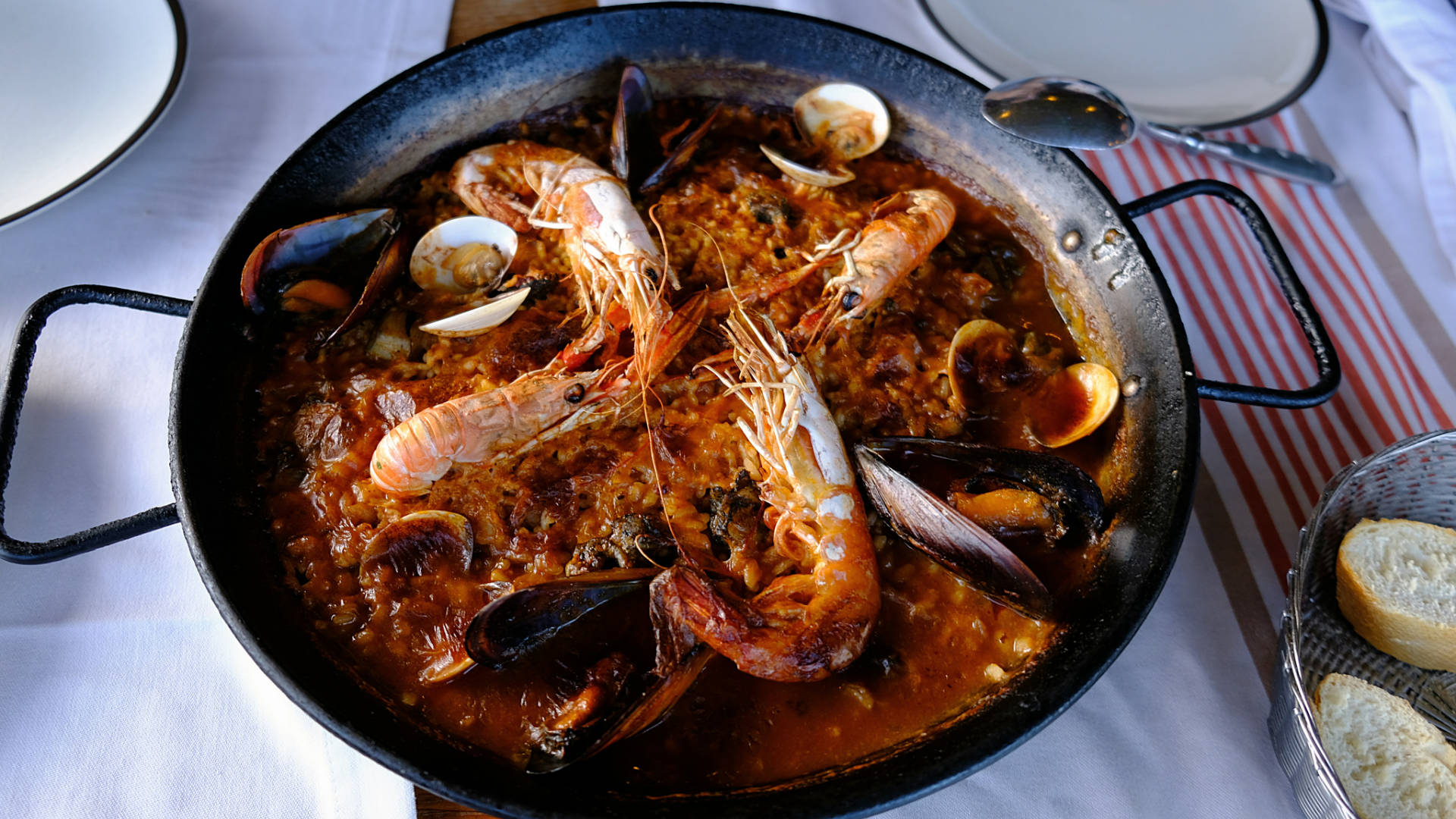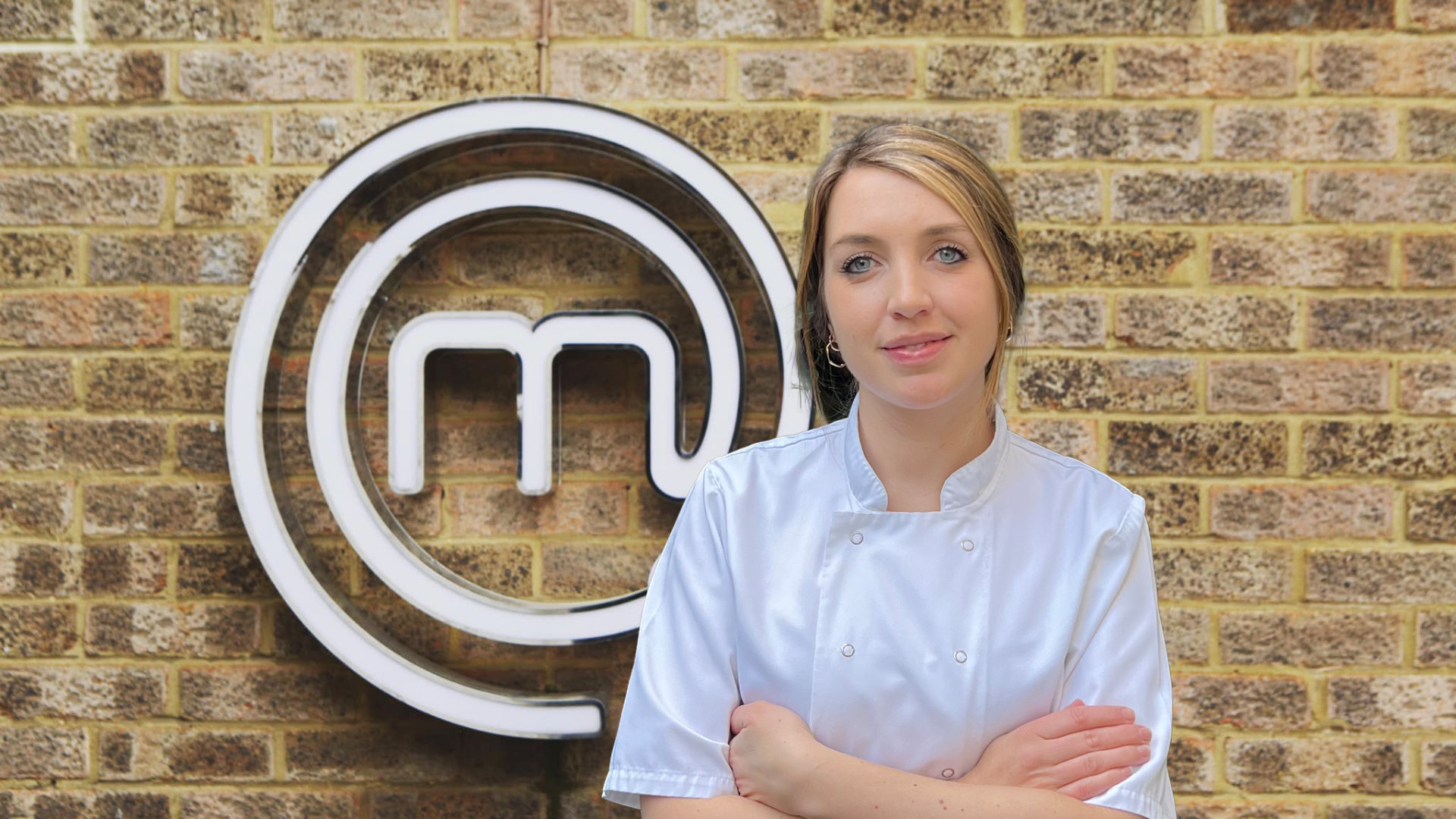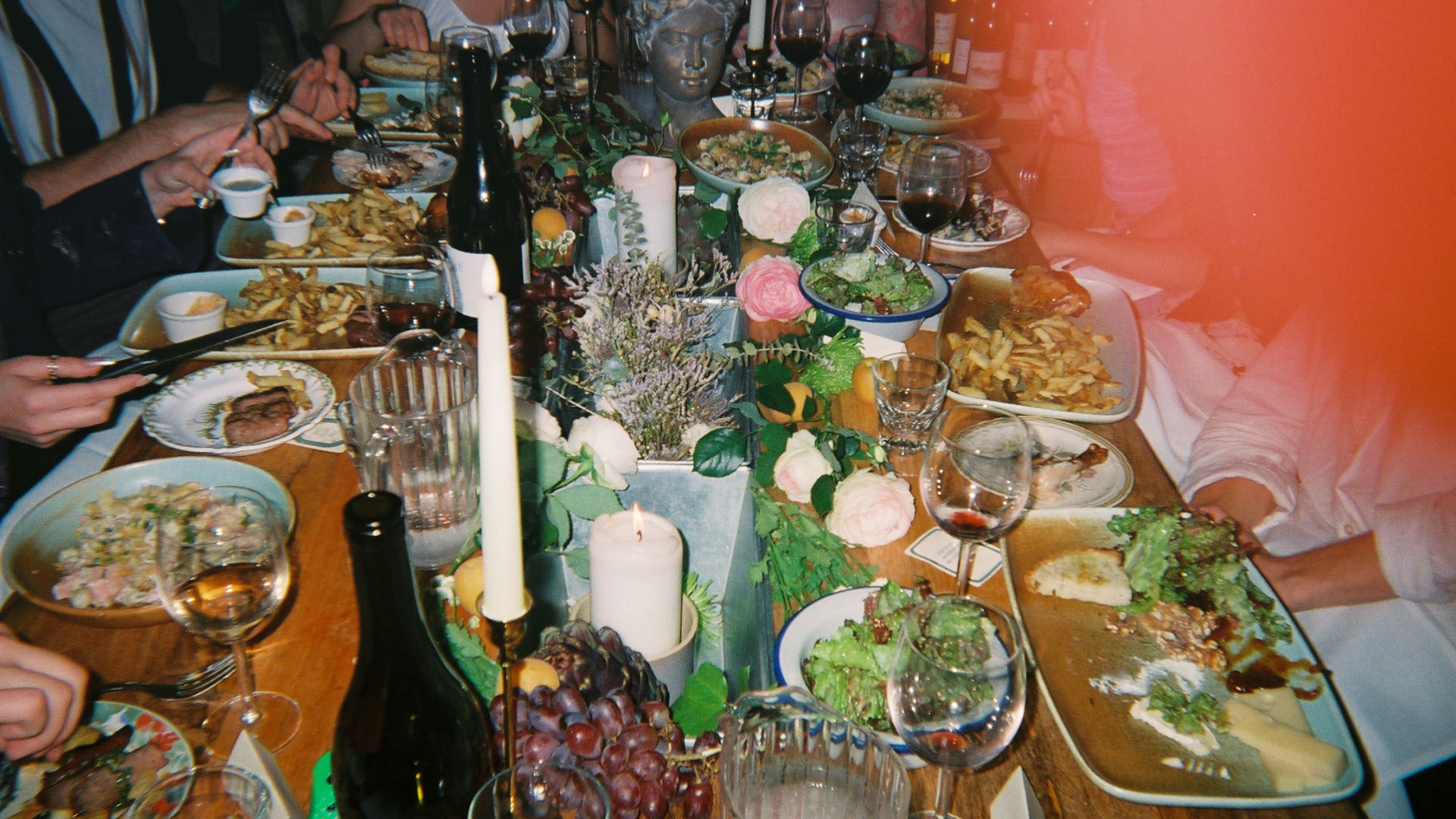It is arguably Spain’s most iconic dish – yet there’s more than one way to make an authentic and delicious paella! Here are five different types of paella that are sure to please every palate – including vegetarians and vegans!
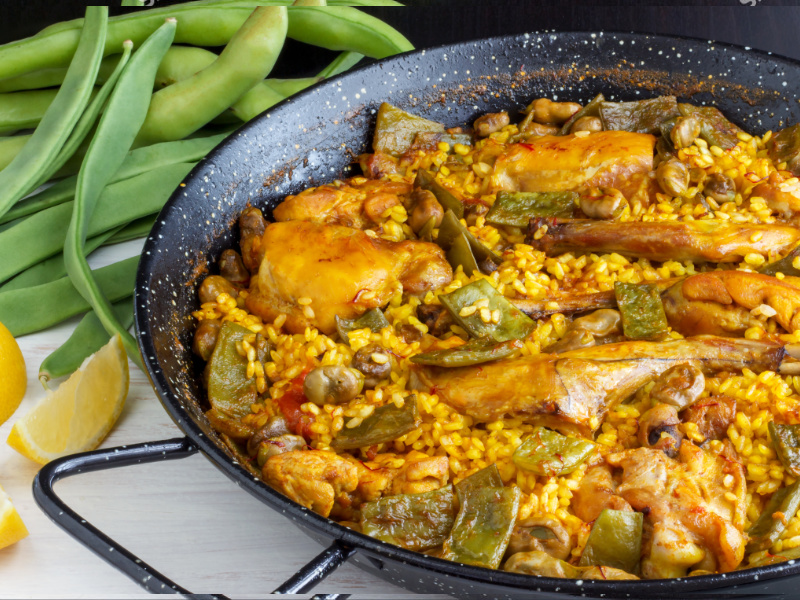
Valencian Paella (Paella Valenciana) – Originating from Valencia, Spain, this classic dish is the epitome of traditional paella. Made with short-grain Bomba rice, saffron, chicken and/or rabbit, green beans and sometimes even snails, it reflects the agricultural and rural roots of the region – not a hint of seafood to be seen!
Seafood Paella (Paella de Marisco) – Unsurprisingly, Paella de Marisco hails from the coastal areas of Spain, especially in regions like Catalonia and Andalusia. It’s a variation that highlights the bounty of the sea and is typically packed with shrimp, clams, mussels, squid and various types of fish making it an intense and flavourful homage to the Mediterranean.
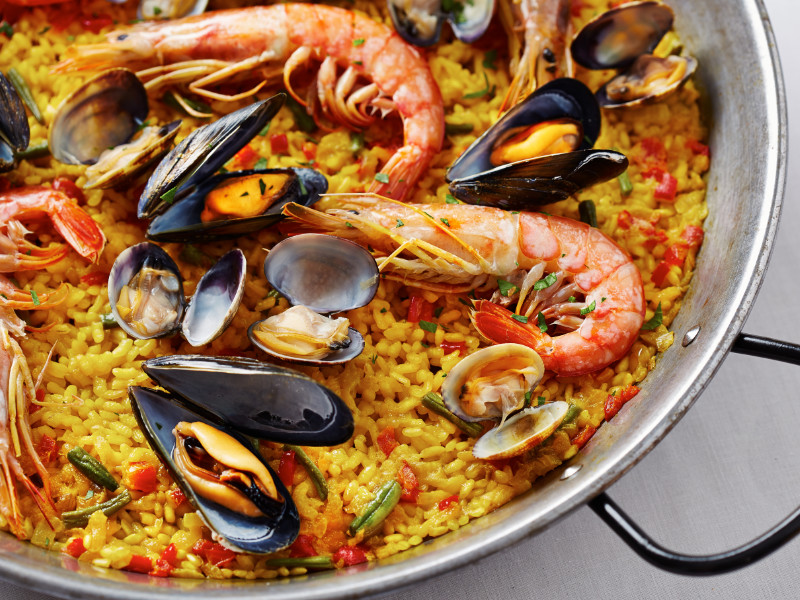
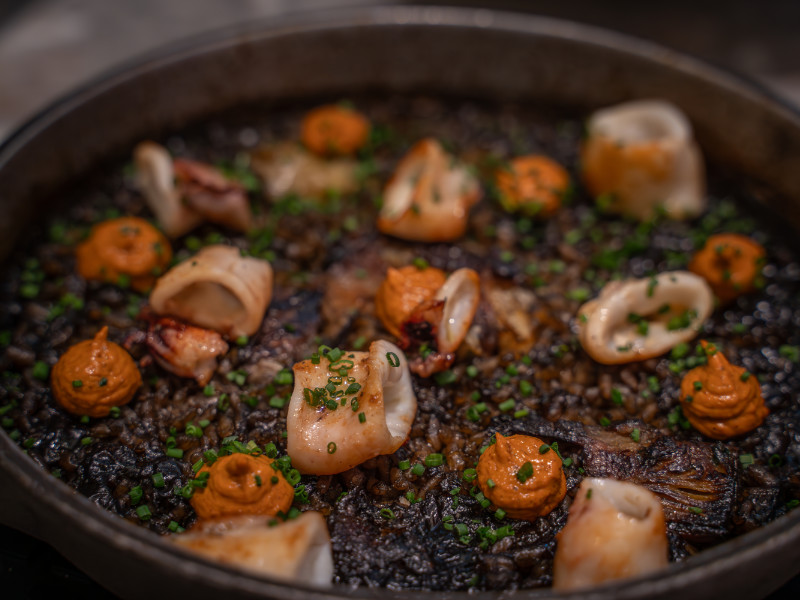
Black Paella (Arroz Negro) – Originating from the coastal regions of Valencia and Catalonia, this striking variation gets its distinctive colour from squid ink. Combined with seafood, garlic, and peppers, it’s a bold and flavourful twist on the traditional dish, offering a taste of the sea with a visually dramatic and distinctive presentation.
Mixed Paella (Paella Mixta) – A popular choice across Spain and beyond, mixed paella combines both land and sea. Typically featuring a combination of chicken, seafood, and vegetables, it offers a diverse array of flavours in every bite and is perhaps the form that is most familiar to those outside Spain.

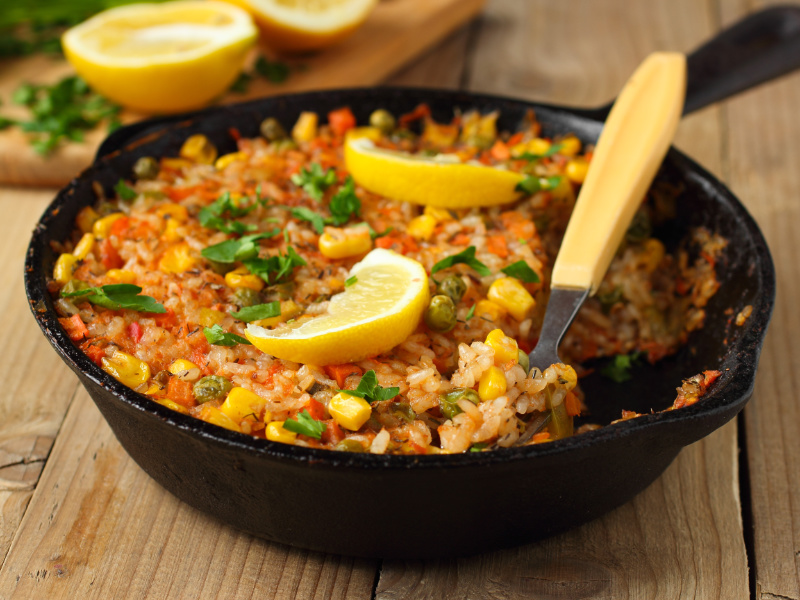
Vegetarian/Vegan Paella (Paella Vegetariana/Vegana) – As paella continues to evolve, so do dietary preferences. This meat-free version, often found in progressive cities like Barcelona or Madrid swaps out the meat for an array of colourful vegetables like bell peppers, artichokes, tomatoes, and peas.
What is the most authentic Spanish paella recipe? It’s a controversial subject! But this classic Paella Valenciana recipe, the latest in our ongoing Must-Try series of foodie articles highlighting recipes from across the culinary Karma-verse, is the traditional chicken paella that many call the original. It combines chicken and either pork ribs or rabbit (your choice!) with green beans, butter beans, garlic, paprika, and saffron. Whatever its provenance we can safely say it’s delicious!
Paella Recipe
Ingredients :
Instructions :
- Place a paella (actually that’s the name of the large pan for making paella) or a large skillet on medium-high heat and add the olive oil. Sprinkle all the salt in a circle towards the edge of the pan to keep the oil from splattering excessively, then add all of the meat (the chicken and either rabbit or pork ribs).
- Brown the meat on all sides over the next 20 minutes, turning it every 3-5 minutes. All of the bits that stick to the pan here will come off when you add the tomato and water in the future, and they’ll really bring a deep flavor to the cooking liquid. Push the browned meat to the edges of the pan, and allow the olive oil to pool in the center.
- Add the green beans and sauté for about 3 minutes.
- Push the beans to the edges and add the garlic. Sauté for about 30 seconds, or until fragrant.
- Add the butter beans. (If you’re using jarred butter beans, be careful not to break them.) Gently toss the beans in the oil and garlic, then let them brown for about 30 seconds per side.
- Add the paprika and gently sauté for about 1 minute. Add the crushed tomatoes and stir everything together. The tomato should start to deglaze the pan (loosening all of the stuck bits below). Use a wooden spoon to scrape off all these flavourful bits and incorporate them into the dish.
- Add the saffron. Make sure to infuse this in a couple tablespoons (30-45 ml) of boiling water for at least 10 minutes prior to adding.
- Pour in 5 cups of water. You’ll add the remaining 4 cups in a moment.
- Add the other 4 cups (960 ml) of water. Boil for about 10 minutes, and then simmer for 15-20 minutes. There should be 5 cups of water left in the pan (the amount needed to make rice for 4 people)
- Add the rice, making sure it’s covered by broth and more or less evenly distributed. Don’t stir after incorporating the rice, no matter how tempted you are! This is key to making sure the rice cooks properly and doesn’t release tons of starch.
- Cook the rice on medium-high for the first 10 minutes, then turn the heat down to medium-low and cook until all the liquid is absorbed, about 8-10 minutes. The exact cook time depends on the variety of rice (for reference, Bomba rice takes 20 minutes in total).
- Another sign the paella is done is a faint crackling sound from the pan, which means the crispy rice, or socarrat, is forming. Once you hear this, turn the heat up for about 30 seconds, but make sure to stop and turn off the heat if you smell burning!
- Take it off the heat and cover it with a dishtowel or newspapers, then let it rest for 5 minutes. Serve the paella family-style–directly out of the pan using a wooden spoon. If you prefer to use plates, just make sure to scrape the bottom of the pan and give everyone some socarrat!
- Paella Valenciana makes the perfect weekend lunch meal. Like the hamburgers at a barbecue, it’s the main event! But while waiting for it to cook, start with some tapas, like gazpacho shooters, ham croquettes, or boiled shrimp.
- Make Ahead: Both the sofrito and stock can be made in advance. You can make the entire dish up to the point of adding the rice, then let it cool and refrigerate for up to 2 days or freeze for up to 3 months.
- When you are ready to prepare the paella, bring the mixture to a rapid simmer and make sure any liquid that evaporates is added back (so you have a 3:1 rice/water ratio). Then add the rice and continue with the recipe as written.
- Leftovers: Store any leftover paella in the fridge in an airtight container for 1-2 days.
- Reheating: Heat up leftover paella on the stove or in the microwave. let it warm up for about 30 minutes before reheating, then put some olive oil in a frying pan and gently stir the paella until it’s heated through.
- The ideal paella rice is a short/medium grain round Variety such as Bomba rice. If necessary, you can substitute Arborio.
Don’t have a paella? Use a large skillet, such as cast iron. Don’t use a small pan, or you’ll have a hard time achieving socarrat. If you can’t find saffron or it’s cost-prohibitive, you can use a pinch of turmeric for colour or simply omit it.
Hard rice? This means it’s not cooked enough. Perhaps you evaporated the liquid too quickly, or didn’t have quite enough to start with. Fix it by covering the cooked paella with a dishtowel or newspapers for 5-10 minutes to steam the rice as it rests. Mushy rice? This means the rice was overcooked, and unfortunately, there’s no quick fix for this. Be sure you have the right rice-to-water ratio for the variety you’re using.
Vegetarian / Vegan Paella Recipe
This traditional Spanish vegetable paella recipe is one of my favorites. It’s typical from Murcia, where they still make paellas on an open fire! This is a vegetarian paella recipe, and the perfect addition to your next barbecue.
Whether you call it paella or not, we all agree that Spanish rice dishes can be exceptionally good.
This easy vegetable paella recipe is a bit different than the Classique paella you might have in mind. My favorite Spanish paellas come from the region of Murcia, where gigantic paella pans are set atop burning grapevines and used to make some of the most delicious family-style meals imaginable.
This vegetarian paella recipe (Arroz de Verduras a la Murciana) is a rice dish that makes use of all the fresh and delicious vegetables that are grown in Murcia. Colourful, healthy and mouthwatering, making this vegetable paella is a dish well worth the trouble!
Ingredients :
This is aproxx for 4 portions of paella. I would add happily eggplants, very very thin sliced. Artichokes, fresh red peppers…
Instructions :
- Dice the mushrooms into bite size pieces and sear in the hot olive oil.
- Remove with a slotted spoon (keeping the oil in the pan) and reserve.
- In the same oil, fry the cloves of whole garlic until tender.
- Remove the cloves of garlic and mash in a mortar and pestle with the parsley and saffron too.
- Add the vegetables to the pan and sauté in the hot olive oil for two minutes.
- Add the garlic paste and the mushrooms (with any juices that came out) back to the pan.
- Add one cup of stock and let everything simmer at a low heat for 20 minutes.
- Add the two cup of rice and four cups of stock to the pan.
- Give everything a stir and bring the mixture to a boil.
- As soon as the liquid starts to boil, lower the heat to low and let it cook for 15-20 minutes — don’t stir during this time!
- When the rice is al dente and the liquid is absorbed, you’re ready to eat!
- To get the beloved socarrat; (the caramelized, lightly burnt crust on the bottom of the paella pan) put a kitchen towel over the finished rice and let it rest for 5 minutes. Then remove the towel and put the paella back on the heat on high. Any liquid at the bottom of the pan will start to evaporate, and when you start to hear a sizzle (in Spain we say it sounds like rain) let it caramelize for about 30 seconds (it should not smell burnt). Remove and serve Immediately.
Seafood Paella Recipe
There is no dish more famous than this Spanish seafood paella. Fortunately, it’s easier than you might think to make this mouthwatering dish from scratch in under an hour!
The most popular version of paella is this seafood paella, or paella de marisco. It became popular on the sunny beaches of Valencia, Malaga and Barcelona with visitors from around the world. This variation of paella is packed with fresh fish, shrimp, squid, mussels, and clams, but the real treasure is the rice. Cooked with saffron and seafood broth, the rice is a sensation all on its own!
This is the dark, crispy layer of rice at the bottom that almost burns as the stock evaporates from the pan. This is a sign of a well-made paella, as it’s the best part of the dish! You’ll love its texture and rich, caramelized flavor.
Ingredients :
Instructions :
- Heat the seafood stock and white wine with a pinch of saffron in a pot. Keep this warm until you need it later; the saffron will infuse into the broth.
- Add olive oil to a large paella pan and start making the sofrito. Sauté the diced onion until translucent, and then add the minced garlic and sauté for a few more minutes.
- Next, add the diced tomatoes, paprika, and a pinch of salt. (If you are using a salty seafood stock, you may want to omit the salt.)
- Stir and cook the sofrito until it has a jam-like texture. The secret to a good sofrito is a bit of time!
- Next, add the squid (calamari). It can be cut into rings or chunks, depending on your preference.
- Coat the calamari in the sofrito and sauté for one minute.
- Now we add the rice!
- There are different opinions on the best method here, but I like to mix it into the sauce and cook it for a minute or so.
- Add the broth mixture to the pan, and don’t stir! This is key: once the broth is in, no stirring is allowed.
- Simmer on low for 10 minutes.
- Add the shrimp or prawns on top, and cook for another 10 minutes. If needed, flip the shrimp after 5 minutes to make sure they’re pink and cooked fully on both sides.
- In the meantime, steam the mussels in a pot. Simmer a little water or wine, then add the closed mussels and cover. After a few minutes, the mussels will open. If any stay shut, simply discard.
- Place the cooked mussels on the paella in a decorative way. When the rice has cooked for 18-20 minutes total, it should be done.
- Remove from the heat, cover with a dish towel, and let stand for 3 minutes. Serve with sliced lemon wedges.
- To get the perfect crispy bottom (socarrat), put it back on medium-high heat after the 3-minute rest. As soon as you hear crackling (some say it sounds like rain), remove it from the heat. This means you’ll have a crispy socarrat on your seafood paella!
Note:
My grandmother will use a hand full of rice per person or about 100gr. And, paella has bay leaves, always! Cloves, one per person, black peppers, grain, a few per portion.
Meat should be 150gr+100 of vegetables.
All this is approximate, in the vegetarian paella and the meat one, I would happily use artichokes, fresh always, clean the hard bit and just use the heart and part of the trunk, sliced thin as 1cm thick.
Regards, Tosh from Karma La Herriza

